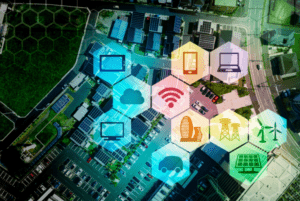6 Electronic Development Trends to Expect in 2024
January 31, 2024
Electronic development and design continue to play a pivotal role in our rapidly evolving technological landscape, shaping our daily lives and interactions. From smartphones that fit in the palm of our hands to smart homes transforming our living spaces, these devices have become indispensable companions, influencing how we navigate the world.
As we enter 2024, it is essential to grasp the key trends propelling this industry forward. From the miniaturization of devices and advancements in wearable technology to the expansion of the Internet of Things (IoT) and artificial intelligence (AI), we delve into the major innovations that will redefine electronics design and development in the years to come. Join us as we unravel the transformative trends shaping the field of electronics in 2024 and beyond.
1. Miniaturization and Wearable Technologies: Small-scale Electronics
Size matters in the electronics world, and the mantra is “smaller is better.” The trend of miniaturization has reached unprecedented sophistication, with engineers and designers tirelessly focused on shrinking electronics and exploring the possibilities in small-scale devices.
From super-thin foldable smartphones to microchips implantable in our bodies, these innovations are made possible by advancements in materials science and manufacturing techniques. This convergence of engineering innovation and user-centric design has given rise to devices seamlessly blending into our lifestyles. Smartwatches monitoring health and augmented reality glasses reshaping our reality are now indispensable companions in our tech-driven world.

Looking ahead to 2024, wearable technology’s landscape is poised for exciting developments, particularly in miniaturization. Advances in semiconductor technologies, enabling smaller yet more powerful electronic components, will drive this evolution. The integration of advanced sensors, efficient energy management systems, and flexible electronics will contribute to compact wearables delivering enhanced functionalities. However, the challenge lies in creating solutions that not only shrink physical size but also enhance versatility and user-friendliness.
Continued emphasis on user experience will be a priority, with designers focusing on making wearables more intuitive and seamlessly integrated into daily routines. The convergence of fashion and technology will play a pivotal role, ensuring wearables excel not only in functionality but also in aesthetics, appealing to a broader audience. Innovations in miniaturization will open doors to novel applications in healthcare, fitness, and augmented reality experiences, representing an exciting frontier where engineering meets the demands of modern living.
2. Connectivity Solutions: Enabling Seamless Integration in IoT Devices
The Internet of Things (IoT) has evolved from a buzzword to a full-blown phenomenon. It represents a network of interconnected devices that can communicate with each other and share data. This network spans various sectors, from smart homes and cities to industrial automation, healthcare, and more. Its profound impact on electronic design and development underscores the importance of connectivity solutions, where technologies like Bluetooth, Wi-Fi, and 5G play pivotal roles.
Beyond being mere communication protocols, these solutions serve as lifelines, facilitating seamless device communication while prioritizing security and a frictionless user experience. Balancing this delicate interplay demands expertise in both hardware and software realms, ensuring effective communication that also prioritizes user privacy and data security.
Looking ahead, the trajectory of IoT signals a surge in connected devices, emphasizing connectivity solutions that transcend traditional boundaries and enable unprecedented levels of interconnectivity and integration. As more and more devices become connected, the challenge lies in crafting electronics that seamlessly integrate into the intricate web of this interconnected ecosystem.

Nevertheless, we foresee a future where the seamless orchestration of devices becomes the norm rather than the exception. Scenarios where smart refrigerators autonomously order groceries or autonomous vehicles communicate seamlessly with traffic lights to optimize traffic flow. The true power of IoT lies not just in individual devices but in their collective ability to create intelligent, interconnected ecosystems. We can expect the development of advanced electronics where connectivity is seamless, secure, and transformative in various industries.
3. Leveraging Intelligent Algorithms with AI and Machine Learning
In the realm of electronics development and design, Artificial Intelligence (AI) and Machine Learning (ML) have become buzzwords in every industry.
In 2024, AI algorithms will be instrumental in optimizing the design process, empowering engineers to create more efficient and effective electronic systems. From optimizing circuit layouts to predicting potential failure points, designers will deploy AI to unlock new possibilities and push the boundaries of achievable outcomes.

Besides that, ML is enhancing devices to be smarter and more intuitive. With applications ranging from voice recognition in smartphones to image recognition in security cameras, ML algorithms are bringing our interactions with electronics to a new level and making them more responsive to our needs.
Anticipating continued advancements, 2024 will witness the integration of AI solutions and algorithms further evolving in electronics design. As these technologies become more accessible and refined, we will witness a new era of intelligent devices that can adapt and evolve based on our preferences and behavior.
4. Focus on Green Innovation: The Push for Sustainability
Due to a growing concern about the environmental impact of electronic devices, there is an increasing focus on developing sustainable and eco-friendly electronics. This trend is driven by both consumer demand for environmentally conscious products and government regulations promoting green innovation.
The use of renewable energy sources is one of the key trends in green electronics. Manufacturers are incorporating solar panels and energy-efficient components into their designs. They will continue to reduce their reliance on fossil fuels and minimize the carbon footprint of electronic devices.
Another trend is the emphasis on recyclability and responsible disposal of electronic waste. Companies are designing products with easy-to-dismantle components, allowing for the efficient recycling and reuse of materials.
Additionally, electronics manufacturers are implementing take-back programs to encourage consumers to properly dispose of their old devices.

4.1 Eco-friendly Materials and Manufacturing Practices
In the pursuit of sustainable electronics, designers are also exploring alternative materials and manufacturing practices. Biodegradable and non-toxic materials are being used to replace traditional components, reducing the environmental impact during the product’s lifecycle.
Furthermore, electronics manufacturers are embracing energy-efficient manufacturing processes that minimize waste but also reduce energy consumption. They are optimizing production lines, reducing chemical usage, and adopting lean manufacturing principles. As consumers become more conscious of their ecological footprint, the demand for green innovation in electronics design will continue to shape the industry in the coming years.
5. High-Speed Communication Technologies and 5G for faster and More Efficient Electronics
With its unparalleled speed and low latency, 5G will continue enabling a wide range of new applications and services that were previously constrained by slower communication infrastructures. High-speed communication technologies, including but not limited to 5G, are redefining the way electronic devices communicate, paving the way for even faster data transfer, reduced latency, and enhanced connectivity. The significance of these advancements extends beyond mere speed; it’s about entering a new era of applications and services across various sectors. From healthcare to manufacturing, it cuts across diverse industries, creating a ripple effect of possibilities.
The integration of 5G into electronic devices unlocks the potential for real-time communication, massive data transfer, and seamless operation of interconnected devices. Aside from 5G, innovations in Wi-Fi, Bluetooth, and other wireless communication standards will also play a significant role.

Electronics designers will navigate the complexities of developing products, utilizing faster processors, increased memory capacity, and improved connectivity to support the demands of high-speed communication and leverage the full potential of 5G technology. From designing circuitry that can handle the demands of rapid data transfer to optimizing protocols for efficient communication, the challenges will be met with a keen understanding of both the hardware and software aspects.
The impact of high-speed communication technologies and 5G on electronics is poised to accelerate. The promise of faster and more efficient electronics translates into tangible benefits for end-users, businesses, and entire industries. This progression is not merely technological but a narrative of empowerment that elevates the capabilities of electronic devices, redefining how we connect, communicate, and innovate in the electronic landscape.
6. Integration of Electronics in Industrial Applications: Robotics and Automation
The field of robotics and automation will continue to evolve, with advancements in electronics design playing a critical role in enabling precise control, sensing capabilities, and decision-making in robotic systems.
The integration of electronics in industrial applications, spanning manufacturing, logistics, healthcare, and agriculture, is transforming various industries. Electronics designers are crafting advanced sensors, actuators, and control systems to enhance the performance and efficiency of robots in these domains.

Designing electronics for industrial automation poses unique challenges, given the harsh conditions such as extreme temperatures, vibrations, and exposure to hazardous substances. Electronics designers will need to develop rugged and durable components capable of withstanding these demanding environments.
Moreover, as automation becomes more sophisticated, electronics designers will be integrating artificial intelligence (AI) and machine learning algorithms into industrial systems. These intelligent electronics will empower robots to learn, adapt, and make real-time decisions, thereby enhancing their autonomy and efficiency.
As the reach of robotics and automation continues to expand, electronics designers will remain crucial in creating robust and intelligent electronics that can meet the diverse demands of various industrial applications.
7. Cutting-edge technologies in Electronics Design
Quantum computing, flexible electronics, and augmented reality (AR) stand out as emerging technologies with tremendous promise for 2024 and beyond. Quantum computing plays a profound role in transforming the electronics design landscape, with the potential to enable complex calculations and problem-solving on an unprecedented scale. It represents not just an incremental improvement but a paradigm shift, redefining the limits of computational capabilities and opening new vistas in scientific research, optimization, and data analysis.
Flexible electronics mark another frontier in electronics design, pushing beyond the constraints of traditional rigid circuits to create bendable and stretchable devices. This innovation transcends conventional form factors, introducing possibilities in wearables, healthcare, and the Internet of Things (IoT), thereby creating devices that seamlessly integrate into the fabric of our lives.

Augmented Reality (AR) technology emerges as a dynamic force in modern electronic design, seamlessly blending the virtual and real world with applications spanning diverse industries. From immersive gaming experiences to transformative applications in education, healthcare, and training, AR is reshaping how we interact with information. The interplay of these innovations extends beyond individual sectors, representing a convergence with the potential to redefine entire industries, shaping the way we live, work, and interact with the digital realm.
Conclusion
Electronic development will continue to shape and transform our lives. From miniaturization to the integration of AI and robotics to the proliferation of smart devices and IoT, 2024 is brimming with exciting possibilities. As we look ahead to the future, it is clear that electronics design and development will continue to push boundaries, unveiling new technologies and innovations that will shape our world in profound ways.
The challenge for electronic engineers will be to harness these technologies and innovations to create products that are not only functional but also enhance our daily lives. They will have to strike a balance between cutting-edge technology and user-centric design, focusing on creating experiences that are intuitive, efficient, and enjoyable. It will be exciting to see how these trends continue to evolve and shape the future of electronics.
FAQs
1. What are the significant trends in electronics development and design in 2024?
Miniaturization and Wearable Technology: The trend towards smaller, more compact electronics and the growing popularity of wearable technology are key developments in electronics design.
Internet of Things (IoT) and Connectivity: The IoT continues to expand, driving the need for improved interconnectivity and integration in electronics design.
Artificial Intelligence (AI) and Machine Learning: AI and machine learning technologies are revolutionizing electronic design, enabling intelligent algorithms and advanced capabilities.
2. How are sustainability and eco-friendliness incorporated into electronics design?
There is a focus on Green Innovation and a heightened emphasis on sustainable electronics design, promoting eco-friendly materials, manufacturing practices, and energy-efficient solutions.
3. How does 5G technology impact electronics development?
Transformative Communication: 5G technology brings high-speed communication capabilities, enabling faster and more efficient electronic development, particularly in areas such as IoT, autonomous vehicles, and augmented reality.
4. What are some exciting emerging technologies in electronics design?
Cutting-Edge Innovations: Emerging technologies in electronics design include advancements like flexible electronics, quantum computing, and nanotechnology, hinting at a future filled with endless possibilities and technological breakthroughs.
